#Campanian
Text

Two male and one female Pteranodon longiceps soar over the heads of a pair of Styxosaurus browni 85 million years ago in what is now the Niobrara Formation of Kansas
#paleoart#paleontology#pteranodon#pterosaur#plesiosaur#niobrara chalk formation#campanian#styxosaurus#cretaceous period#late cretaceous
444 notes
·
View notes
Text

Campanian/Etruscan small bronze statue depicting a Scythian archer and his horse. The archer is removable. The horse is a piece meant to be placed atop an urn.
5th Century BCE. Currently in the Metropolitan Museum of Art.
#art#culture#history#ancient culture#ancient art#ancient history#scythians#scythian#campania#campanian#etruscan#military history#the metropolitan#the met#the metropolitan museum of art
56 notes
·
View notes
Text

I’m on a roll with the late cretaceous period. Say hi to the Gorgosaurus!
#paleoart#dino art#dinosaur#gorgosaurus#late cretaceous#campanian#tried to be accurate with the hexagonal scale pattern on the tale but idk how exactly that looked#stagart
161 notes
·
View notes
Photo
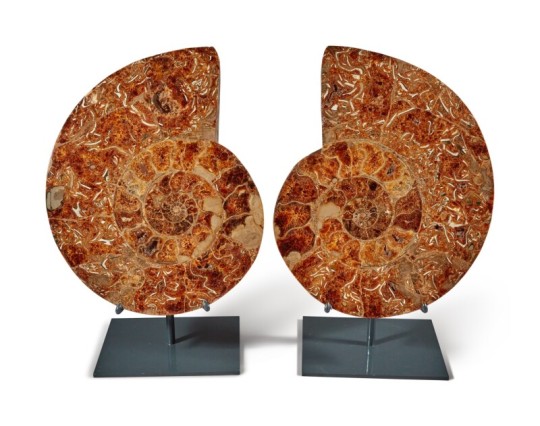

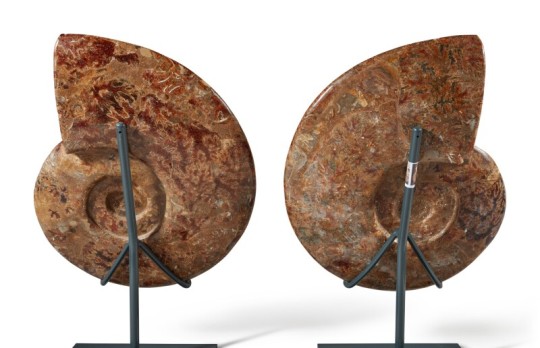
A Very Large Split Ammonite
Pachydiscus Cretaceous, Campanian
Belo Sur Tsiribihina, Madagascar
80 cm in diameter, split and polished, each half presented on a custom stand. A beautifully fossilized specimen of exceptional size, with honey-colored calcite and a few cavities with crystals.
Pachydiscus is an extinct genus of ammonite from the Upper Cretaceous with a global distribution. The species of this genus is P. neubergicus; in total, some 28 species have been described.
#A Very Large Split Ammonite#Pachydiscus Cretaceous#Campanian#Belo Sur Tsiribihina Madagascar#fossil#palaeontology#archeology#archeolgst#history#history news#ancient history
38 notes
·
View notes
Text


0 notes
Text
Time Travel Question 36: Prehistory (Iteration Unknown)
These Questions are the result of suggestions from the previous iteration.
Please add new suggestions below if you have them for future consideration. All cultures and time periods welcome.
#Time Travel#Prehistory#Paleontology#Dinosaurs#Perucetus#Pangea#Campanian Ignimbrite Supervolcano#The Ediacaran Period#Evolution#Extinct Animals#Diplodicus#Deinonychus#Acrocanthosaurus#The Glen Rose Trackway Hunt#Andrewsarchus
377 notes
·
View notes
Text
i found a fc for reina.............it's been 84 years
#leah.txt#i'm :0#i've had her for years and could never really find someone that fit... i'm 👀#like her nose is a tiny bit different and her skin is a lil darker but i mean mainly just cause she tans super easily (she's campanian &#sicilian ☺️) but i am like hulloooo lips are lichrally the perfect shape wtf and her jaw/cheek structure and eye and hair colour... even if#reina's hair is naturally curlier but she does straighten it a lot and style it in like loose waves. sometimes she#just lets it vibe but like. many thoughts going on there. (projects)#thank you to that lesbian brazilian show for popping up on my dash because i'm screeching . also yearning. but screeching
5 notes
·
View notes
Text
Reading information that could potentially make my professor very unhappy.
#beablabbers#absolutely nothing academia related he just married an italian and another dozent told me his inlaws don't buy campanian tomatos#bc of all the entanglement with improper waste deposit. well. guess who also improperly managed that#and planted veggies on landfills. the north.
0 notes
Text
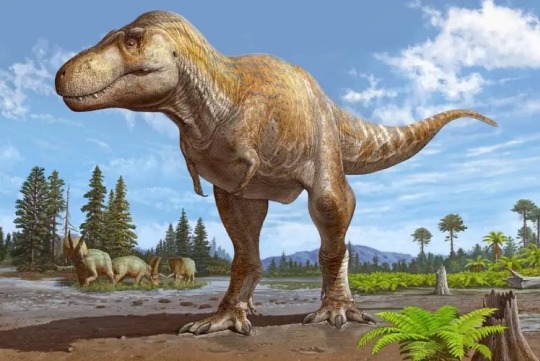
well, it seems a new Tyrannosaurus species was described today! the paper, (authored by Sebastian G. Dalman, Mark A. Loewen, and Nicholas R. Longrich) is based on remains from ancient Laramidia (now New Mexico) previously attributed to T. rex. These particular fossils are dated 6-7ish million years before T. rex. This newly proposed species, Tyrannosaurus mcraeensis, will hopefully give some insight into the evolution of T. rex, which has largely been shrouded in mystery.
The working theory has been migration from what is now Asia, *but* if T. mcraeensis continues to hold up to scrutiny it would turn out that the reverse is true! or even that a double back migration saw large tyrannosaurine dinosaurs migrate to Asia, only to migrate once again towards the northern part of North America!
Obviously the paper goes into far more detail, so i’ve included it below. give it a look!
(art at the top of the post was made by Sergey Krasovskiy)
#paleoart#dinosaurs#palaeoblr#dinosaur#paleontology#mesozoic#Tyrannosaurus mcraeensis#Tyrannosaurus rex#T rex
1K notes
·
View notes
Text
Lokiceratops rangiformis Loewen et al., 2024 (new genus and species)
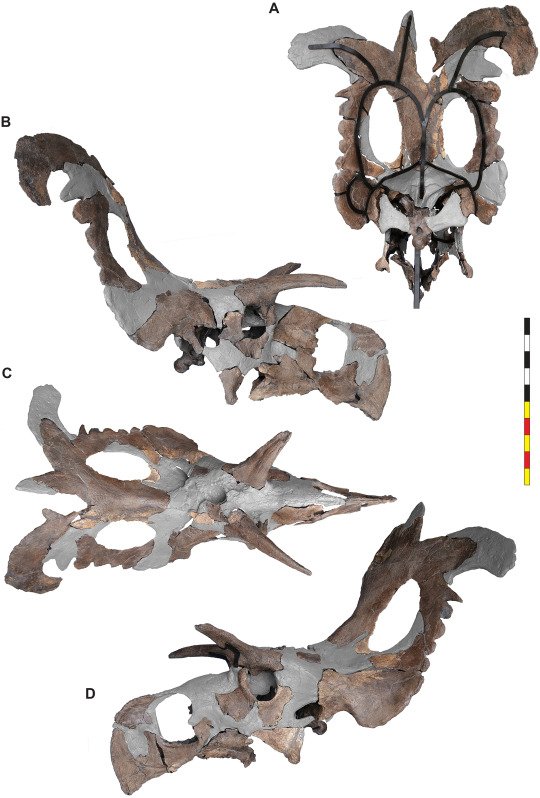
(Reconstructed skull of Lokiceratops rangiformis [scale bar = 1 m], with unpreserved portions in gray, from Loewen et al., 2024)
Meaning of name: Lokiceratops = [Norse deity] Loki's horned face [in Greek]; rangiformis = Rangifer [genus of the extant reindeer]-shaped [in Latin]
Age: Late Cretaceous (Campanian), roughly 78.1 million years ago
Where found: Judith River Formation, Montana, U.S.A.
How much is known: Partial skeleton of one individual, including a partial skull, several vertebrae, and some limb bones.
Notes: Lokiceratops was a centrosaurine cereratopsian, making it a horned dinosaur more closely related to Styracosaurus and Pachyrhinosaurus than to Triceratops. It is one of the largest known centrosaurines, with its skull alone being nearly 2 m long.
The skull of Lokiceratops was highly distinctive. A pair of very large, curved horns at the back of its frill pointed out to the sides. Furthermore, a pair of smaller horns closer to the center of the frill was asymmetrical, with one horn being larger than the other. Asymmetrical head ornamentation is also seen in the antlers of reindeer, hence the species name "rangiformis".
Lokiceratops is known from approximately the same time and location as three other centrosaurines, Albertaceratops, Medusaceratops, and Wendiceratops. Despite their diversity, all centrosaurines discovered so far are only known from very narrow ranges in both time and space. This may suggest that these horned dinosaurs diversified rapidly into numerous forms differentiated primarily by display features such as the shape of their horns and frills, with each species lasting only a short time in a small geographic region before evolving into new species or going extinct.
Reference: Loewen, M.A., J.J.W. Sertich, S. Sampson, J.K. O’Connor, S. Carpenter, B. Sisson, A. Øhlenschlæger, A.A. Farke, P.J. Makovicky, N. Longrich, and D.C. Evans. 2024. Lokiceratops rangiformis gen. et sp. nov. (Ceratopsidae: Centrosaurinae) from the Campanian Judith River Formation of Montana reveals rapid regional radiations and extreme endemism within centrosaurine dinosaurs. PeerJ 12: e17224. doi: 10.7717/peerj.17224
412 notes
·
View notes
Text
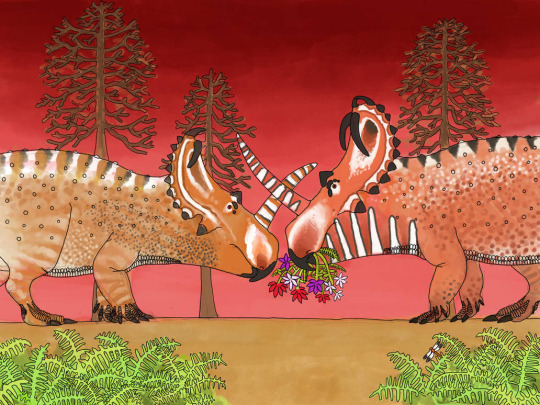
Love is in the Air: Centrosaurus Edition
A male Centrosaurus apertus offers a special gift of flowers to his mate 75 million years ago in what is now the Dinosaur Park Formation of Alberta, Canada.
#paleoart#dinosaur#dinosaurs#paleontology#valentines day#valentines gifts#valentine#centrosaurus#cerstopsian#ceratopsidae#campanian#dinosaur art#artists on tumblr#paleoartist#paleoartists on tumblr
201 notes
·
View notes
Text

Lokiceratops rangiformis was a ceratopsian dinosaur that lived during the Late Cretaceous (~78 million years ago) in what is now Montana, USA. Estimated at about 6.7m long (~22ft), it was one of the largest known members of the centrosaurine branch of the ceratopsians.
It had a unique arrangement of ornamentation on its skull, with no nose horn, two long brow horns, and a pair of huge asymmetrical curving blade-like spikes on the top of its square frill – some of the largest known frill spikes of any ceratopsian.
It lived in a swampy environment near the shore of the Western Interior Seaway, in an area that seems to have had an unusually high diversity of ceratopsians – along with Lokiceratops there were three other centrosaurines (Medusaceratops, Albertaceratops, and Wendiceratops), and one chasmosaurine (Judiceratops).
(There's also a possibility that it might not actually be a unique species. We know some other ceratopsians' faces changed quite drastically as they aged, so Lokiceratops could instead represent a fully mature individual of Medusaceratops.)
———
NixIllustration.com | Tumblr | Patreon
References:
Gramling, Carolyn. "Meet Lokiceratops, a newly discovered species of horned dinosaur." Science News, 20 June 2024, https://www.sciencenews.org/article/lokiceratops-new-species-horned-dinosaur
Loewen, Mark A., et al. "Lokiceratops rangiformis gen. et sp. nov.(Ceratopsidae: Centrosaurinae) from the Campanian Judith River Formation of Montana reveals rapid regional radiations and extreme endemism within centrosaurine dinosaurs." PeerJ 12 (2024): e17224. https://doi.org/10.7717/peerj.17224
Molinek, Rudy. “Dinosaur with Giant, Loki-like Horns Has the ‘craziest, Coolest’ Headgear-and Could Be a New Species.” Smithsonian Magazine, 20 June 2024, https://www.smithsonianmag.com/smart-news/dinosaur-with-giant-loki-like-horns-has-the-craziest-coolest-headgear-and-could-be-a-new-species-180984577/
Wikipedia contributors. “Lokiceratops.” Wikipedia, 1 Jul. 2024, https://en.wikipedia.org/wiki/Lokiceratops
#science illustration#paleontology#paleoart#palaeoblr#lokiceratops#centrosaurinae#ceratopsidae#ceratopsian#marginocephalia#ornithischia#dinosaur#art
346 notes
·
View notes
Text

A Campanian Autumn
Parasaurolophus walkeri is distracted by falling leaves.
#illustration#paleoart#art#paleontology#paleo#sciart#artistsontumblr#digitalart#science#digitalillustration#parasaurolophus#fall#autumn#leaves#foliage#human artist
450 notes
·
View notes
Text
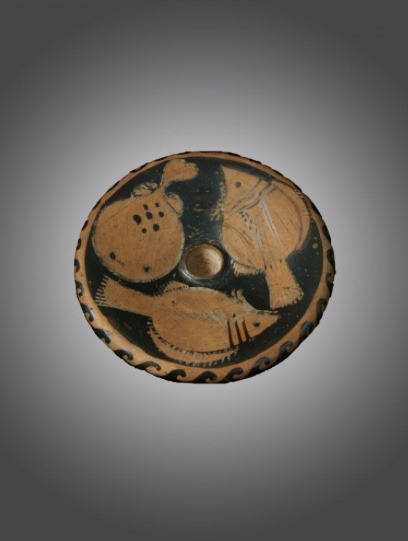
Campanian Red-Figure Fish Plate
360-330 BC
The Three-Stripe Painter.
Two breams and a torpedo around a central well.
ø 18.5 cm.
#Campanian Red-Figure Fish Plate#360-330 BC#pottery#ancient pottery#ancient artifacts#archeology#archeolgst#history#history news#ancient history#ancient culture#ancient civilizations#ancient greece#greek history#greek art
152 notes
·
View notes
Text


Ankylosaurian sacrum from our anky site. Campanian, Judith River fm near Havre, MT.
#badlands dinosaur museum#fossil#fossils#palaeoblr#paleoblr#paleontology#palaeontology#dinosaurs#fieldwork#judith river formation#fieldwork 2024
175 notes
·
View notes
Text

[Q: How could western North America support such a high diversity of ecologically similar, large-bodied horned dinosaur species during the late Campanian? A: It could not—or, the Red Queen takes an axe to a phylogenetic tree, restructuring an ecological network from within rather than without]
This is the title.
Berry (2023)
553 notes
·
View notes